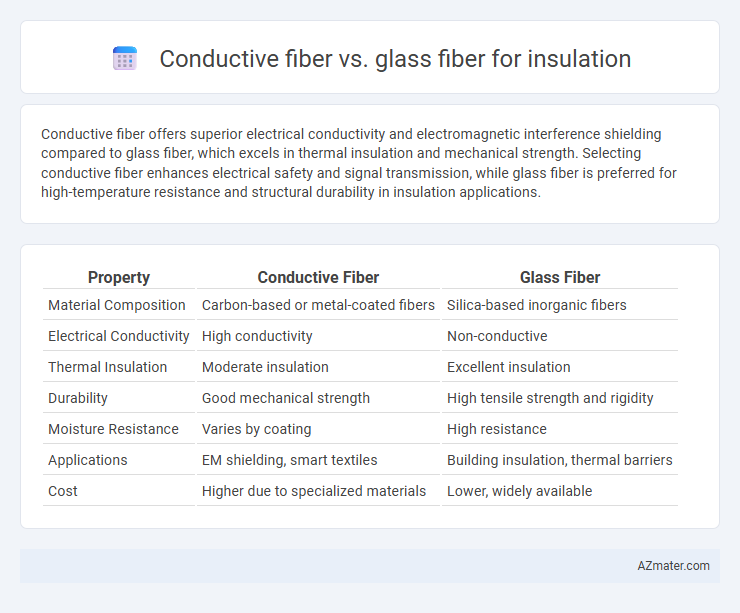Conductive fiber offers superior electrical conductivity and electromagnetic interference shielding compared to glass fiber, which excels in thermal insulation and mechanical strength. Selecting conductive fiber enhances electrical safety and signal transmission, while glass fiber is preferred for high-temperature resistance and structural durability in insulation applications.
Table of Comparison
| Property | Conductive Fiber | Glass Fiber |
|---|---|---|
| Material Composition | Carbon-based or metal-coated fibers | Silica-based inorganic fibers |
| Electrical Conductivity | High conductivity | Non-conductive |
| Thermal Insulation | Moderate insulation | Excellent insulation |
| Durability | Good mechanical strength | High tensile strength and rigidity |
| Moisture Resistance | Varies by coating | High resistance |
| Applications | EM shielding, smart textiles | Building insulation, thermal barriers |
| Cost | Higher due to specialized materials | Lower, widely available |
Overview of Conductive Fiber and Glass Fiber
Conductive fibers are engineered materials designed to transmit electrical signals or heat, commonly used in smart textiles and electromagnetic interference shielding. Glass fibers, composed of fine strands of silica-based materials, offer excellent thermal insulation, mechanical strength, and resistance to moisture and chemicals. While conductive fibers prioritize electrical conductivity and flexibility, glass fibers excel in thermal insulation and structural reinforcement applications.
Key Properties and Composition
Conductive fibers, typically composed of carbon or metal-coated polymers, offer superior electrical conductivity and thermal dissipation, making them ideal for applications requiring electromagnetic interference shielding and heat management. Glass fibers, primarily made from silica-based materials, excel in thermal insulation, mechanical strength, and chemical resistance while being non-conductive, which makes them suitable for electrical insulation and structural reinforcement. The choice between conductive and glass fibers depends on the need for electrical conductivity versus insulating properties, with metallic content and fiber morphology playing critical roles in performance outcomes.
Insulation Performance Comparison
Conductive fibers exhibit low electrical resistance, making them unsuitable for insulation purposes, whereas glass fibers provide excellent electrical insulation due to their high resistivity and dielectric strength. Glass fiber insulation effectively resists heat and electrical currents, maintaining stable performance under high temperatures and preventing electrical conductivity. The inherent properties of glass fibers enable superior thermal and electrical insulation compared to conductive fibers, which are primarily designed for electrical conductivity applications.
Thermal Conductivity Differences
Conductive fiber exhibits significantly higher thermal conductivity compared to glass fiber, making it less effective as an insulator but suitable for applications requiring heat dissipation. Glass fiber's low thermal conductivity, typically around 0.04 W/m*K, provides excellent thermal insulation, reducing heat transfer and energy loss. The difference in thermal properties is critical when selecting materials for insulation, as conductive fibers facilitate heat flow while glass fibers trap air to maintain temperature.
Electrical Characteristics and Safety
Conductive fibers, typically composed of materials like carbon or metal alloys, offer low electrical resistance and are used in applications requiring electromagnetic shielding or static dissipation, enhancing safety by reducing the risk of electric shock and interference. Glass fibers, primarily made from silica, are excellent electrical insulators due to their high dielectric strength and non-conductive properties, ensuring effective insulation and minimizing electrical hazards in high-voltage environments. The choice between conductive and glass fibers depends on specific electrical requirements, with glass fiber favored for insulation performance and conductive fiber selected for controlled conductivity and grounding applications.
Mechanical Strength and Durability
Conductive fibers typically exhibit lower mechanical strength and durability compared to glass fibers, which are renowned for their high tensile strength and excellent resistance to environmental degradation. Glass fibers maintain insulation integrity under mechanical stress and prolonged exposure to heat, moisture, and chemicals, making them ideal for demanding insulation applications. In contrast, conductive fibers may degrade faster under similar conditions due to oxidation and mechanical wear, limiting their long-term durability in insulation roles.
Cost-Effectiveness and Availability
Conductive fiber insulation typically offers higher initial costs but can provide energy savings due to its ability to dissipate static and improve thermal regulation, making it cost-effective in long-term applications. Glass fiber insulation is widely available, affordable, and has established manufacturing processes, contributing to its dominance in budget-sensitive projects. The choice depends on balancing upfront investment with performance benefits, where glass fiber excels in availability and low cost, while conductive fibers may justify higher costs through enhanced functional properties.
Environmental Impact and Sustainability
Conductive fiber insulation typically uses materials like carbon or metal-based fibers that have higher environmental costs due to energy-intensive production processes and limited recyclability. Glass fiber insulation, made primarily from silica sand and recycled glass, offers better sustainability with lower embodied energy and higher potential for reuse and recycling. The lifecycle assessment of glass fiber insulation shows a reduced carbon footprint compared to conductive fibers, making it a more environmentally friendly option for sustainable building applications.
Installation Process and Practical Considerations
Conductive fibers offer easier installation due to their flexibility and lightweight structure, reducing labor time and allowing for custom fitting in complex layouts. Glass fibers require careful handling and protective gear during installation due to their brittleness and potential skin irritation but provide superior thermal insulation and fire resistance. Practical considerations include the conductive fiber's susceptibility to moisture and electrical interference, while glass fiber demands precise cutting and sealing to maintain insulation integrity.
Ideal Applications and Use Cases
Conductive fiber is ideal for applications requiring electromagnetic interference (EMI) shielding and static dissipation in electronics, wearable technology, and aerospace industries. Glass fiber excels in thermal and electrical insulation, mechanical reinforcement, and fire-resistant applications such as construction, automotive, and electrical equipment. The choice depends on whether electrical conductivity or thermal resistance and structural support are the primary requirements.

Infographic: Conductive fiber vs Glass fiber for Insulation
 azmater.com
azmater.com